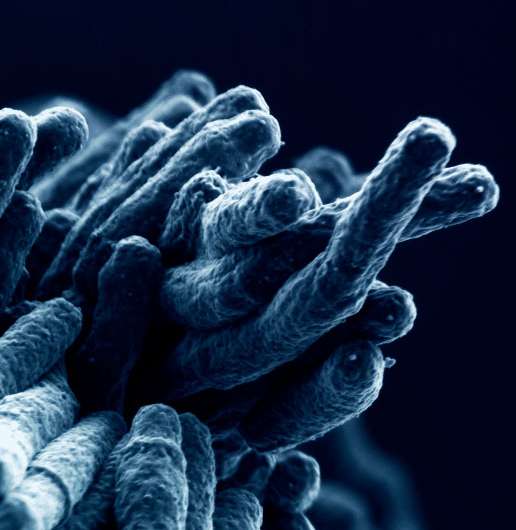How the tuberculosis bacterium tricks the immune system

Scientists at EPFL have discovered how the tuberculosis bacterium can trick the patient's immune cells to lower their defenses.
Tuberculosis is caused by the bacterium Mycobacterium tuberculosis and it affects over 12 million people globally. When the bacterium infects a person, the body's immune response is critical to how the disease will progress; either helping the body fight the bacterium or, if certain key molecules become involved, actually exacerbating the infection. EPFL scientists now show how the tuberculosis bacterium co-opts mechanisms of the immune system to its own advantage. The study is published in Cell Host & Microbe.
The body fights tuberculosis: Inflammasome, interleukins, interferons
When M. tuberculosis infects a person, it attacks the lungs' first-response immune cells, the macrophages. The immune response by the macrophages involves a complex of four different proteins called the "inflammasome". The main role of the inflammasome is to prepare certain immunity proteins in the macrophages, which are called "interleukins". When M. tuberculosis infects the lungs, interleukins from the macrophages are in the first line of defense.
But if it is left uncontrolled, this defense can also cause serious damage to the patient. To prevent this, macrophages also release another group of proteins called "type I interferons". While interferons are important for defending the body against viruses, when it comes to tuberculosis they actually help the bacterium, thereby exacerbating the disease. And although the interleukin-inflammation part of the immune response is rather well understood, the part involving interferons has been elusive.
DNA trickery
The lab of Andrea Ablasser at EPFL, in collaboration with the lab of Stewart Cole, has now discovered how M. tuberculosis carries out a subtle assault on our immune defenses. The key is a molecule called cGAS, which is found in the lung's macrophages, and is part of a group of DNA-sensor molecules; in short, cGAS patrols the inside of macrophages, and when it detects unidentified pieces of DNA, such as those released by M. tuberculosis, it triggers an immune response from the macrophages.
The tuberculosis bacterium uses a specialized secretion system to release its array of toxic proteins into macrophages. But, strangely, it also releases small bits of DNA, which are detected by sensing systems inside the macrophages, namely the inflammasome and cGAS. This causes macrophages to release two types of proteins: interleukin-1, which fights the bacterium, and type I interferons, which end up helping it.
Ablasser's group used human and animal macrophages to study what happens when they are infected by M. tuberculosis. What they found was that the bacterium passes DNA bits into the macrophages, thereby tricking cGAS to signal the production of interferons, which reduce the immune response. In other words, the bacterium tricks the macrophages to cut back on their defense against it.
But the researchers did not stop there. They also showed that it is possible to manipulate M. tuberculosis in such a way that it can no longer activate the production of interferons through cGAS, while still keeping the production of interleukin-1 - and thus the body's immune response - intact.
The study is the first to identify cGAS as a sensor for M. tuberculosis DNA, and also suggests that this method of molecular manipulation applies to other bacteria that use specialized secretion systems to infect cells. "Our work shows that tuberculosis is a far more sophisticated disease than previously thought," says Andrea Ablasser, who is now working, among other projects, to identify the DNA pieces that M. tuberculosis uses to trick macrophages.
More information: Wassermann R, Gulen MF, Sala C, Perin SG, Lou Y, Rybniker J, Schmid-Burgk JL, Schmidt T, Hornung V, Cole ST, Ablasser A. The ESX-1 secretion system of Mycobacterium tuberculosis differentially regulates cGAS- and inflammasome-dependent intracellular immune responses. Cell Host & Microbe 2 June 2015.


















